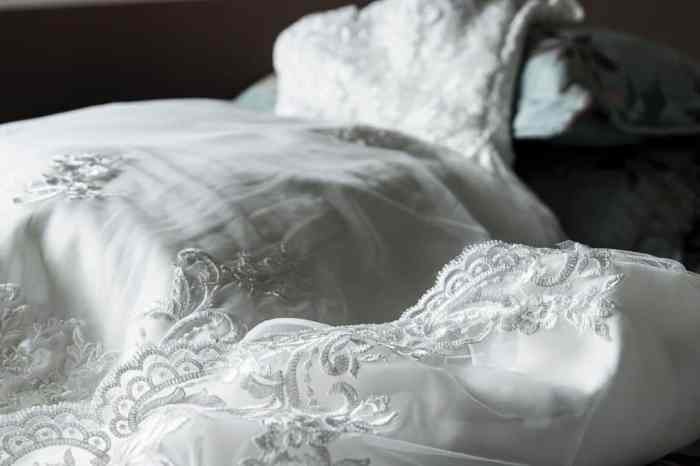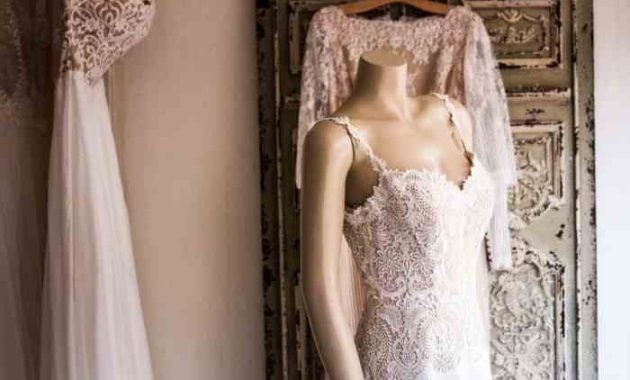Factors Influencing Wedding Dress Dry Cleaning Costs
Cost to dry clean a wedding dress – Several factors contribute to the final cost of dry cleaning your wedding gown. Understanding these elements helps in budgeting and selecting a service that aligns with your needs and expectations. The price isn’t just about the cleaning itself; it encompasses the care required for the specific garment.
Factors Affecting Wedding Dress Dry Cleaning Prices
The cost of cleaning a wedding dress varies significantly depending on several key factors. The following table summarizes these key influences:
| Material Type | Embellishments | Dress Size | Location |
|---|---|---|---|
| Silk, delicate lace, beaded fabrics generally cost more to clean due to their fragility and require specialized handling. Sturdier fabrics like satin or taffeta are usually less expensive to clean. | Intricate beading, embroidery, or delicate appliqués significantly increase cleaning costs due to the extra time and care needed to prevent damage. Simple embellishments will typically result in lower costs. | Larger dresses require more cleaning solution and time, potentially leading to higher costs. Smaller dresses generally cost less to clean. | Dry cleaning prices vary geographically; urban areas often have higher costs than rural areas due to higher overhead and labor expenses. |
The Impact of Intricate Detailing on Cost
The level of detail on your wedding dress directly impacts the cleaning price. Intricate beading, heavy embroidery, or delicate lace require meticulous hand-cleaning to prevent damage or loss of embellishments. This specialized care is more time-consuming and thus more expensive than cleaning a simpler gown.
Geographic Location and Pricing
The cost of dry cleaning a wedding dress can vary considerably based on location. Dry cleaners in major metropolitan areas tend to have higher operating costs, including rent and labor, leading to higher prices compared to those in smaller towns or rural areas. Competition also plays a role; a highly competitive market may lead to lower prices.
Fabric Type and Cost Comparison
Different fabrics require different cleaning methods and levels of care, impacting the cost. Delicate fabrics like silk and lace necessitate gentler, more specialized cleaning, increasing the price. Sturdier fabrics such as satin or taffeta are generally less expensive to clean.
- Silk: Requires specialized cleaning due to its delicate nature. Expect higher costs.
- Satin: Relatively easy to clean, usually resulting in lower costs.
- Lace: Can be delicate and require hand-cleaning, leading to higher costs depending on the intricacy.
Types of Dry Cleaning Services for Wedding Dresses

Source: weddingfrontier.com
Various dry cleaning methods exist for wedding dresses, each with its own advantages and disadvantages. Choosing the right method depends on the fabric, embellishments, and your budget.
Comparison of Dry Cleaning Methods
Several methods exist for cleaning wedding dresses, each with its own benefits and drawbacks. Consider these options carefully when making your decision.
The cost to dry clean a wedding dress can vary significantly depending on the fabric and embellishments. If you’re considering a less formal option for a wedding guest outfit, you might explore more affordable choices like the beautiful and lightweight chiffon cocktail dresses for weddings , which often require simpler and therefore less expensive cleaning. Ultimately, understanding the cleaning costs beforehand helps budget effectively for your wedding attire, whether it’s a gown or a cocktail dress.
- Dry Cleaning (Perc): Traditional method using perchloroethylene (Perc) solvent. Cost-effective but Perc is a harsh solvent and can be damaging to some fabrics over time. Not environmentally friendly.
- Dry Cleaning (Hydrocarbon): Uses a gentler solvent than Perc, better for the environment and less likely to damage delicate fabrics. More expensive than Perc-based dry cleaning.
- Wet Cleaning: Uses water-based cleaning solutions. Excellent for delicate fabrics and environmentally friendly. More expensive than traditional dry cleaning and requires experienced cleaners to avoid shrinkage or damage.
Wet Cleaning vs. Dry Cleaning
Wet cleaning uses water and specialized detergents, ideal for delicate fabrics. Dry cleaning, traditionally using Perc or hydrocarbons, avoids water contact but can be harsher on certain materials. The choice depends on the dress fabric and the cleaner’s expertise.
Benefits of Specialized Wedding Dress Cleaning Services
Specialized services possess the expertise and equipment to handle the unique challenges posed by wedding gowns. They often use gentler cleaning methods, provide preservation services, and offer insurance against damage. This added care and peace of mind usually come at a higher cost but are worth considering for a valuable garment.
Cost Differences Between Service Levels
| Service Level | Description | Approximate Cost Range |
|---|---|---|
| Basic Cleaning | Standard cleaning to remove surface dirt and stains. | $150 – $300 |
| Preservation Cleaning | Includes cleaning, pressing, and packaging for long-term storage. | $300 – $600 |
| Spot Cleaning | Treatment of specific stains or areas. | $50 – $150 (per stain or area) |
Note: Cost ranges are estimates and vary significantly based on location, dress type, and the cleaner’s pricing.
Finding Affordable Wedding Dress Dry Cleaning Options

Source: com.au
Finding a reputable and affordable dry cleaner for your wedding dress requires research and careful consideration. Several strategies can help you find a balance between quality and cost.
Steps to Finding a Reputable and Affordable Dry Cleaner
- Get Recommendations: Ask friends, family, or wedding planners for referrals.
- Check Online Reviews: Look for reviews on sites like Yelp or Google My Business.
- Compare Prices: Get quotes from several dry cleaners to compare pricing and services.
- Verify Insurance or Guarantees: Ensure the cleaner offers insurance against damage.
- Inquire About Experience: Ask about their experience cleaning wedding dresses.
Cost-Saving Strategies
- Clean Soon After the Wedding: Fresh stains are easier and cheaper to remove.
- Consider Spot Cleaning: If only minor cleaning is needed, spot cleaning can save money.
- Shop Around: Compare prices from multiple dry cleaners.
Risks of Inexpensive or Inexperienced Cleaners
Using inexpensive or less experienced cleaners poses risks of damage to your dress. Inexperienced cleaners may lack the expertise to handle delicate fabrics or intricate embellishments, leading to potential damage or irreversible stains. Always prioritize quality over price.
Questions to Ask Potential Dry Cleaners
- What is your experience cleaning wedding dresses?
- What cleaning methods do you use?
- Do you offer insurance or guarantees against damage?
- What is your turnaround time?
- Can I see examples of your previous work?
Preservation and Storage of a Dry-Cleaned Wedding Dress
Proper storage is crucial to preserving your wedding dress for years to come. Following these guidelines will help maintain its condition and prevent damage.
Methods for Storing a Dry-Cleaned Wedding Dress
To ensure your wedding dress remains in pristine condition, store it in a cool, dry, and dark place, away from direct sunlight and moisture. Acid-free tissue paper should be used to wrap the dress, preventing yellowing or discoloration. A breathable garment bag made of acid-free materials is recommended for long-term storage.
Importance of Acid-Free Tissue Paper and Storage Containers, Cost to dry clean a wedding dress
Acid-free tissue paper prevents yellowing and discoloration, common problems with long-term storage. Acid-free containers, such as archival-quality boxes, further protect the dress from dust, light, and moisture. Avoid using plastic bags, which can trap moisture and cause damage.
Ideal Storage Environment
The ideal storage environment for a wedding dress is cool, dark, and dry. Maintain a temperature between 65-70°F (18-21°C) and a relative humidity of 40-50%. Fluctuations in temperature and humidity can cause damage to the fabric and embellishments. A climate-controlled environment is ideal.
Folding or Hanging a Wedding Dress for Storage
Whether to fold or hang your wedding dress depends on its construction and fabric. Delicate fabrics, such as silk or lace, are best folded and laid flat to prevent stretching or damage. Sturdier fabrics can be hung on a padded hanger, ensuring the garment is not stretched or strained. Always use acid-free tissue paper to prevent yellowing or damage.
Addressing Common Concerns and Misconceptions
Several misconceptions surround wedding dress dry cleaning. Understanding these issues helps in making informed decisions and minimizing risks.
Common Misconceptions About Wedding Dress Dry Cleaning
- Myth: Dry cleaning always removes all stains. Fact: Some stains, particularly those set in, may be difficult or impossible to remove completely.
- Myth: Any dry cleaner can handle a wedding dress. Fact: Specialized cleaners with experience handling delicate fabrics and embellishments are essential.
- Myth: Dry cleaning is always the best option. Fact: Wet cleaning may be more suitable for delicate fabrics.
Possibility of Damage During Cleaning and Risk Minimization
Damage during the cleaning process is possible, though less likely with experienced cleaners. To minimize risks, choose a reputable cleaner with a good reputation and insurance against damage. Inspect your dress carefully before and after cleaning.
Importance of Insurance or Guarantees
Insurance or guarantees offered by dry cleaners provide protection against damage during the cleaning process. This safeguard is crucial, given the value and sentimental significance of a wedding dress. Always inquire about insurance before leaving your dress for cleaning.
Handling Stains or Minor Damage Before Cleaning
Addressing stains or minor damage before sending your dress for cleaning can help minimize the cost and potential for irreversible damage. Gentle spot cleaning with appropriate stain removers can be effective. However, for significant damage, consult a professional cleaner before attempting any treatment.
Questions Often Asked: Cost To Dry Clean A Wedding Dress
Can I dry clean my wedding dress at home?
It’s strongly discouraged. Home cleaning methods can damage delicate fabrics and embellishments. Professional cleaning is recommended.
How long does it take to dry clean a wedding dress?
Turnaround time varies depending on the cleaner and the complexity of the dress, but typically ranges from a few days to several weeks.
What if my dress is damaged during the cleaning process?
Reputable cleaners offer insurance or guarantees to cover accidental damage. Always inquire about their policies beforehand.
Should I remove stains before taking my dress to the cleaner?
While you should avoid aggressive stain removal, it’s best to point out any stains to the cleaner before the cleaning process begins.

